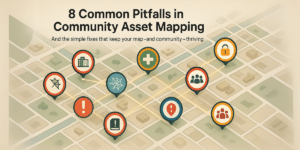
Sustaining Network Engagement | 5 Tips From the Field
Last winter, we conducted a survey of network leaders to identify the top issues they’re dealing with. One of the top responses was sustaining network engagement: keeping partners involved and committed to their participation in the network over the long-term. It’s typical for engagement to start out strong and fade over time as other priorities come to the forefront, and can undermine the network’s ability to reach shared goals.
Sustaining Network Engagement Isn’t Easy.
First of all, don’t take this issue personally. Network engagement is a common issue – according to our survey it’s one of the top three problems faced by network leaders. The issue of lagging engagement is emblematic of the core problem many networks face: Being locked in a “more is better” mentality that overwhelms network leaders and members with too much communication and not enough to show for it. With a little mindset shift, it’s possible to do better. Here’s how advice for sustaining network engagement.
Give Partners a Specific Role to Play
Many people have a tendency to invite all their partners to everything. We view a non-invitation as an insult – when in reality, it’s often a relief! Give each of your partners in the network a specific role to play, and only invite them to meetings or calls when they can play that role. Make sure they know they can always attend if they’d like, while saving specific invites for the times you need them.
Be Intentional About Building Connections
Before you bring in someone new to the network, consider which connections are necessary and which are redundant. Connections take time to maintain; the more you build, the less time you have to dedicate to each. Focus on building the least number of connections to reach your shared goals to limit the stress on both you and your potential partners.
Balance Your Communication
Just as meetings can become overwhelming for network partners, emails and newsletters can also become a nuisance. Use varying levels of communication depending on the context of each partner. Core network members need more regular updates and communication than peripheral members who serve a specific role. Try to use communication methods that are best accepted by your partners, whether that’s email, zoom meetings, phone calls, social media messages, slack, or something else unique.
Maintain An Open Dialogue
If you aren’t openly discussing engagement in your network, partners may not feel like they’re able to voice their concerns. Ensure you’re creating an open environment where any network members can voice concerns about reciprocity in the network. If members feel like they’re giving more time and energy to the group than they are saving, it’s no wonder their engagement starts to fade. Have regular sessions to talk through these issues so members feel respected and their participation valued.
Create Your Goals Collectively
When we feel ownership over something, we’re more likely to stay engaged and involved with it. If your network uses a collaborative process to create goals, members are much more likely to feel ownership and stay engaged. Try using a consent-based decision-making process to review and adapt your goals so all members feel connected to the outcomes you’re all aiming for. If someone is brought in new, take time to update goals so they remain collective and shared in nature.
Sustaining Network Engagement is Possible!
It may not be easy, but sustaining network engagement is possible! The above five tips will go a long way in engaging your network partners. Not sure where to begin? The PARTNER Community Partner Relationship Management System (CPRM) is a great solution for implementing all our advice. Survey your partners over time to analyze your connections, metrics like trust and value, and adapt your network to boost engagement and involvement. Here’s another great resource on sustaining engagement.

About the Author: Alex Derr, M.P.A.
Director of Marketing & Communications
Alex joined VNL in 2017, originally supporting our events. He now helps manages our communications and marketing strategy and content development work. Alex creates blogs, infographics, reports, and other content while managing our web and social media presence. He also runs our email marketing campaigns, tracks analytics, and conducts market research to drive our strategy. He supports our entire team with copywriting, graphic design and research, and helps with events, webinars, demos, and other online learning. When he isn’t at work Alex spends his time climbing 14ers (30 done, 28 to go!) and blogging on his own website, The Next Summit Blog.





